Analyzing Nokia's Failure in the Global Smartphone Industry: A Report
VerifiedAdded on 2021/06/14
|9
|2940
|455
Report
AI Summary
This report provides an in-depth analysis of Nokia's failure in the global smartphone industry. It begins with an executive summary and introduction, tracing Nokia's history and its initial dominance in the mobile phone market. The study then delves into the reasons behind Nokia's decline, including its inability to adapt to the changing technological landscape, particularly the rise of smartphones and the competition from Android and iOS. The report examines Nokia's strategic issues, including its rigid adherence to the Symbian operating system, and its micro and macro environmental factors. It also highlights the importance of the international business environment for companies and analyzes Nokia's strategies to deal with market ecology. The report concludes with recommendations for how Nokia could have navigated the challenges and maintained its market position, emphasizing the need for technological adaptation, investment in R&D, and a focus on customer expectations. The report underscores the critical role of adapting to technological advancements, competitive pressures, and evolving consumer preferences in the rapidly changing telecommunications industry.
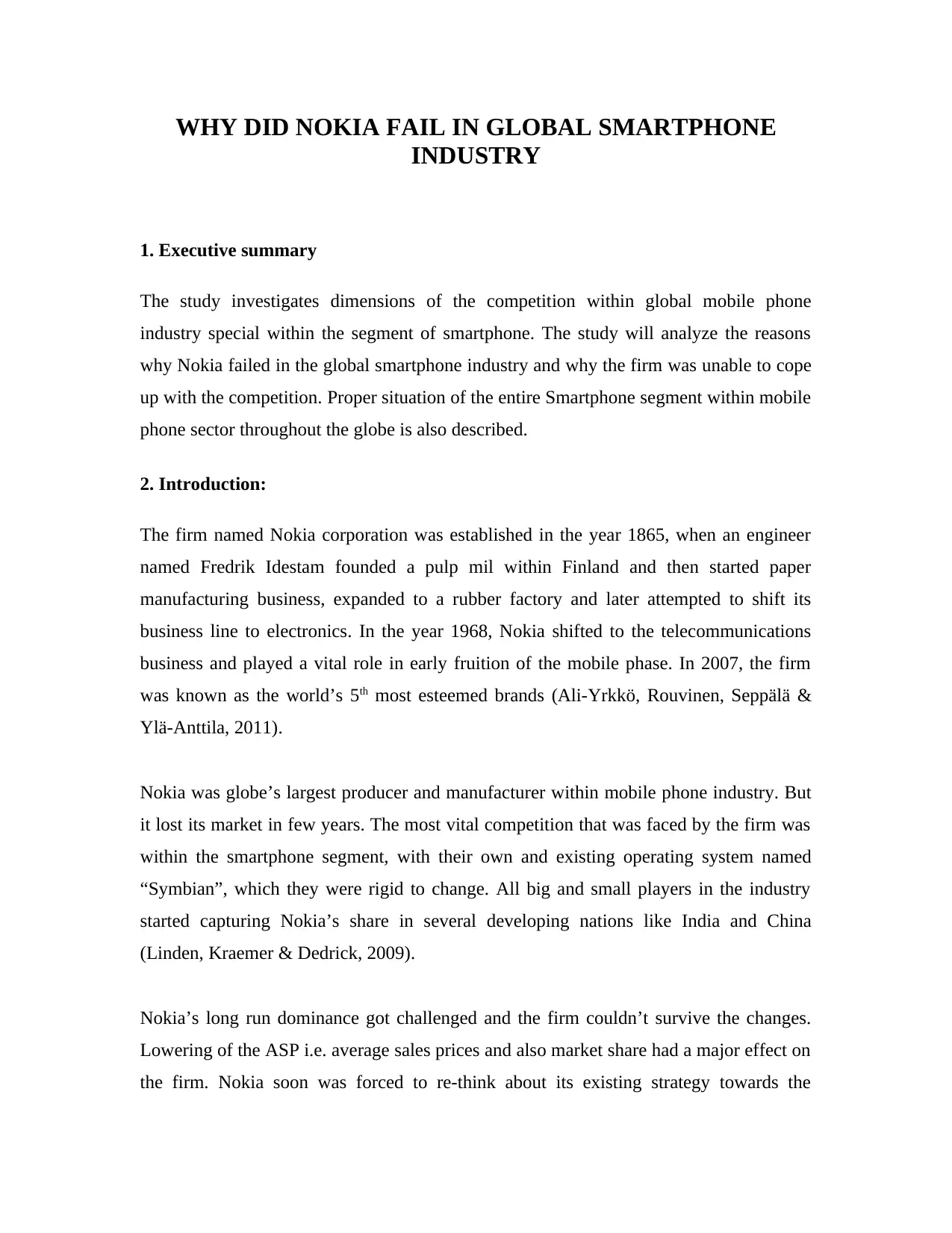
WHY DID NOKIA FAIL IN GLOBAL SMARTPHONE
INDUSTRY
1. Executive summary
The study investigates dimensions of the competition within global mobile phone
industry special within the segment of smartphone. The study will analyze the reasons
why Nokia failed in the global smartphone industry and why the firm was unable to cope
up with the competition. Proper situation of the entire Smartphone segment within mobile
phone sector throughout the globe is also described.
2. Introduction:
The firm named Nokia corporation was established in the year 1865, when an engineer
named Fredrik Idestam founded a pulp mil within Finland and then started paper
manufacturing business, expanded to a rubber factory and later attempted to shift its
business line to electronics. In the year 1968, Nokia shifted to the telecommunications
business and played a vital role in early fruition of the mobile phase. In 2007, the firm
was known as the world’s 5th most esteemed brands (Ali-Yrkkö, Rouvinen, Seppälä &
Ylä-Anttila, 2011).
Nokia was globe’s largest producer and manufacturer within mobile phone industry. But
it lost its market in few years. The most vital competition that was faced by the firm was
within the smartphone segment, with their own and existing operating system named
“Symbian”, which they were rigid to change. All big and small players in the industry
started capturing Nokia’s share in several developing nations like India and China
(Linden, Kraemer & Dedrick, 2009).
Nokia’s long run dominance got challenged and the firm couldn’t survive the changes.
Lowering of the ASP i.e. average sales prices and also market share had a major effect on
the firm. Nokia soon was forced to re-think about its existing strategy towards the
INDUSTRY
1. Executive summary
The study investigates dimensions of the competition within global mobile phone
industry special within the segment of smartphone. The study will analyze the reasons
why Nokia failed in the global smartphone industry and why the firm was unable to cope
up with the competition. Proper situation of the entire Smartphone segment within mobile
phone sector throughout the globe is also described.
2. Introduction:
The firm named Nokia corporation was established in the year 1865, when an engineer
named Fredrik Idestam founded a pulp mil within Finland and then started paper
manufacturing business, expanded to a rubber factory and later attempted to shift its
business line to electronics. In the year 1968, Nokia shifted to the telecommunications
business and played a vital role in early fruition of the mobile phase. In 2007, the firm
was known as the world’s 5th most esteemed brands (Ali-Yrkkö, Rouvinen, Seppälä &
Ylä-Anttila, 2011).
Nokia was globe’s largest producer and manufacturer within mobile phone industry. But
it lost its market in few years. The most vital competition that was faced by the firm was
within the smartphone segment, with their own and existing operating system named
“Symbian”, which they were rigid to change. All big and small players in the industry
started capturing Nokia’s share in several developing nations like India and China
(Linden, Kraemer & Dedrick, 2009).
Nokia’s long run dominance got challenged and the firm couldn’t survive the changes.
Lowering of the ASP i.e. average sales prices and also market share had a major effect on
the firm. Nokia soon was forced to re-think about its existing strategy towards the
Paraphrase This Document
Need a fresh take? Get an instant paraphrase of this document with our AI Paraphraser
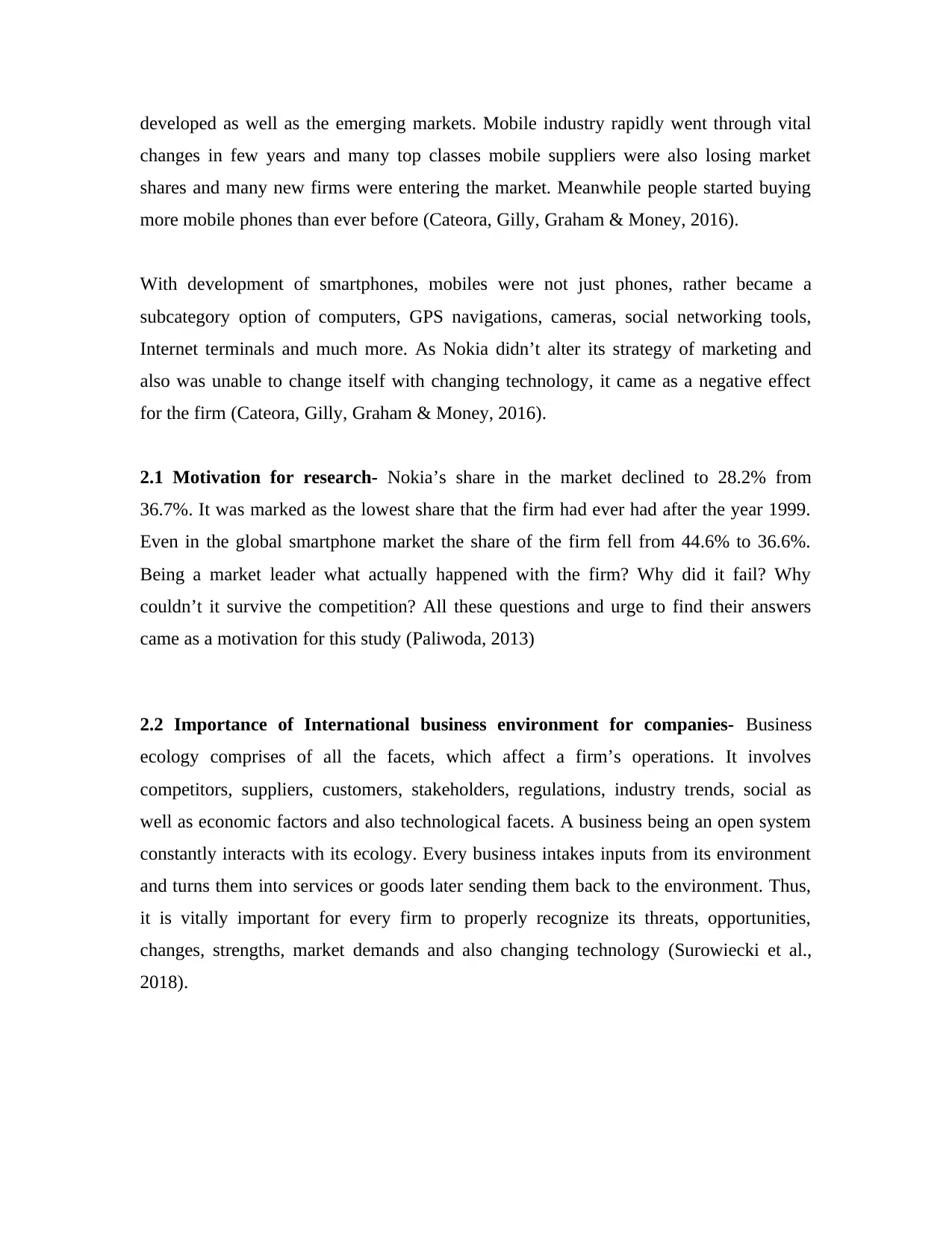
developed as well as the emerging markets. Mobile industry rapidly went through vital
changes in few years and many top classes mobile suppliers were also losing market
shares and many new firms were entering the market. Meanwhile people started buying
more mobile phones than ever before (Cateora, Gilly, Graham & Money, 2016).
With development of smartphones, mobiles were not just phones, rather became a
subcategory option of computers, GPS navigations, cameras, social networking tools,
Internet terminals and much more. As Nokia didn’t alter its strategy of marketing and
also was unable to change itself with changing technology, it came as a negative effect
for the firm (Cateora, Gilly, Graham & Money, 2016).
2.1 Motivation for research- Nokia’s share in the market declined to 28.2% from
36.7%. It was marked as the lowest share that the firm had ever had after the year 1999.
Even in the global smartphone market the share of the firm fell from 44.6% to 36.6%.
Being a market leader what actually happened with the firm? Why did it fail? Why
couldn’t it survive the competition? All these questions and urge to find their answers
came as a motivation for this study (Paliwoda, 2013)
2.2 Importance of International business environment for companies- Business
ecology comprises of all the facets, which affect a firm’s operations. It involves
competitors, suppliers, customers, stakeholders, regulations, industry trends, social as
well as economic factors and also technological facets. A business being an open system
constantly interacts with its ecology. Every business intakes inputs from its environment
and turns them into services or goods later sending them back to the environment. Thus,
it is vitally important for every firm to properly recognize its threats, opportunities,
changes, strengths, market demands and also changing technology (Surowiecki et al.,
2018).
changes in few years and many top classes mobile suppliers were also losing market
shares and many new firms were entering the market. Meanwhile people started buying
more mobile phones than ever before (Cateora, Gilly, Graham & Money, 2016).
With development of smartphones, mobiles were not just phones, rather became a
subcategory option of computers, GPS navigations, cameras, social networking tools,
Internet terminals and much more. As Nokia didn’t alter its strategy of marketing and
also was unable to change itself with changing technology, it came as a negative effect
for the firm (Cateora, Gilly, Graham & Money, 2016).
2.1 Motivation for research- Nokia’s share in the market declined to 28.2% from
36.7%. It was marked as the lowest share that the firm had ever had after the year 1999.
Even in the global smartphone market the share of the firm fell from 44.6% to 36.6%.
Being a market leader what actually happened with the firm? Why did it fail? Why
couldn’t it survive the competition? All these questions and urge to find their answers
came as a motivation for this study (Paliwoda, 2013)
2.2 Importance of International business environment for companies- Business
ecology comprises of all the facets, which affect a firm’s operations. It involves
competitors, suppliers, customers, stakeholders, regulations, industry trends, social as
well as economic factors and also technological facets. A business being an open system
constantly interacts with its ecology. Every business intakes inputs from its environment
and turns them into services or goods later sending them back to the environment. Thus,
it is vitally important for every firm to properly recognize its threats, opportunities,
changes, strengths, market demands and also changing technology (Surowiecki et al.,
2018).
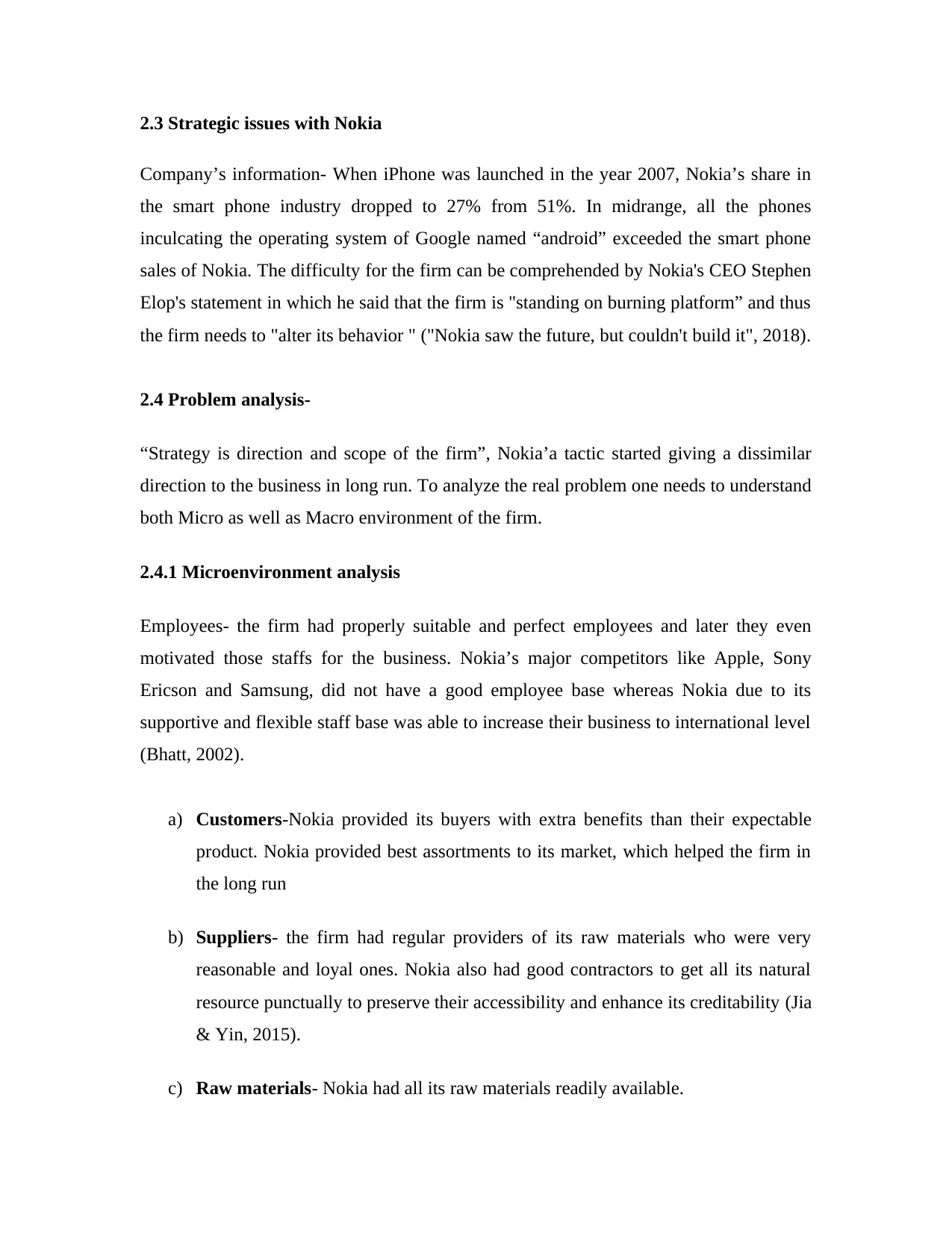
2.3 Strategic issues with Nokia
Company’s information- When iPhone was launched in the year 2007, Nokia’s share in
the smart phone industry dropped to 27% from 51%. In midrange, all the phones
inculcating the operating system of Google named “android” exceeded the smart phone
sales of Nokia. The difficulty for the firm can be comprehended by Nokia's CEO Stephen
Elop's statement in which he said that the firm is "standing on burning platform” and thus
the firm needs to "alter its behavior " ("Nokia saw the future, but couldn't build it", 2018).
2.4 Problem analysis-
“Strategy is direction and scope of the firm”, Nokia’a tactic started giving a dissimilar
direction to the business in long run. To analyze the real problem one needs to understand
both Micro as well as Macro environment of the firm.
2.4.1 Microenvironment analysis
Employees- the firm had properly suitable and perfect employees and later they even
motivated those staffs for the business. Nokia’s major competitors like Apple, Sony
Ericson and Samsung, did not have a good employee base whereas Nokia due to its
supportive and flexible staff base was able to increase their business to international level
(Bhatt, 2002).
a) Customers-Nokia provided its buyers with extra benefits than their expectable
product. Nokia provided best assortments to its market, which helped the firm in
the long run
b) Suppliers- the firm had regular providers of its raw materials who were very
reasonable and loyal ones. Nokia also had good contractors to get all its natural
resource punctually to preserve their accessibility and enhance its creditability (Jia
& Yin, 2015).
c) Raw materials- Nokia had all its raw materials readily available.
Company’s information- When iPhone was launched in the year 2007, Nokia’s share in
the smart phone industry dropped to 27% from 51%. In midrange, all the phones
inculcating the operating system of Google named “android” exceeded the smart phone
sales of Nokia. The difficulty for the firm can be comprehended by Nokia's CEO Stephen
Elop's statement in which he said that the firm is "standing on burning platform” and thus
the firm needs to "alter its behavior " ("Nokia saw the future, but couldn't build it", 2018).
2.4 Problem analysis-
“Strategy is direction and scope of the firm”, Nokia’a tactic started giving a dissimilar
direction to the business in long run. To analyze the real problem one needs to understand
both Micro as well as Macro environment of the firm.
2.4.1 Microenvironment analysis
Employees- the firm had properly suitable and perfect employees and later they even
motivated those staffs for the business. Nokia’s major competitors like Apple, Sony
Ericson and Samsung, did not have a good employee base whereas Nokia due to its
supportive and flexible staff base was able to increase their business to international level
(Bhatt, 2002).
a) Customers-Nokia provided its buyers with extra benefits than their expectable
product. Nokia provided best assortments to its market, which helped the firm in
the long run
b) Suppliers- the firm had regular providers of its raw materials who were very
reasonable and loyal ones. Nokia also had good contractors to get all its natural
resource punctually to preserve their accessibility and enhance its creditability (Jia
& Yin, 2015).
c) Raw materials- Nokia had all its raw materials readily available.
⊘ This is a preview!⊘
Do you want full access?
Subscribe today to unlock all pages.

Trusted by 1+ million students worldwide
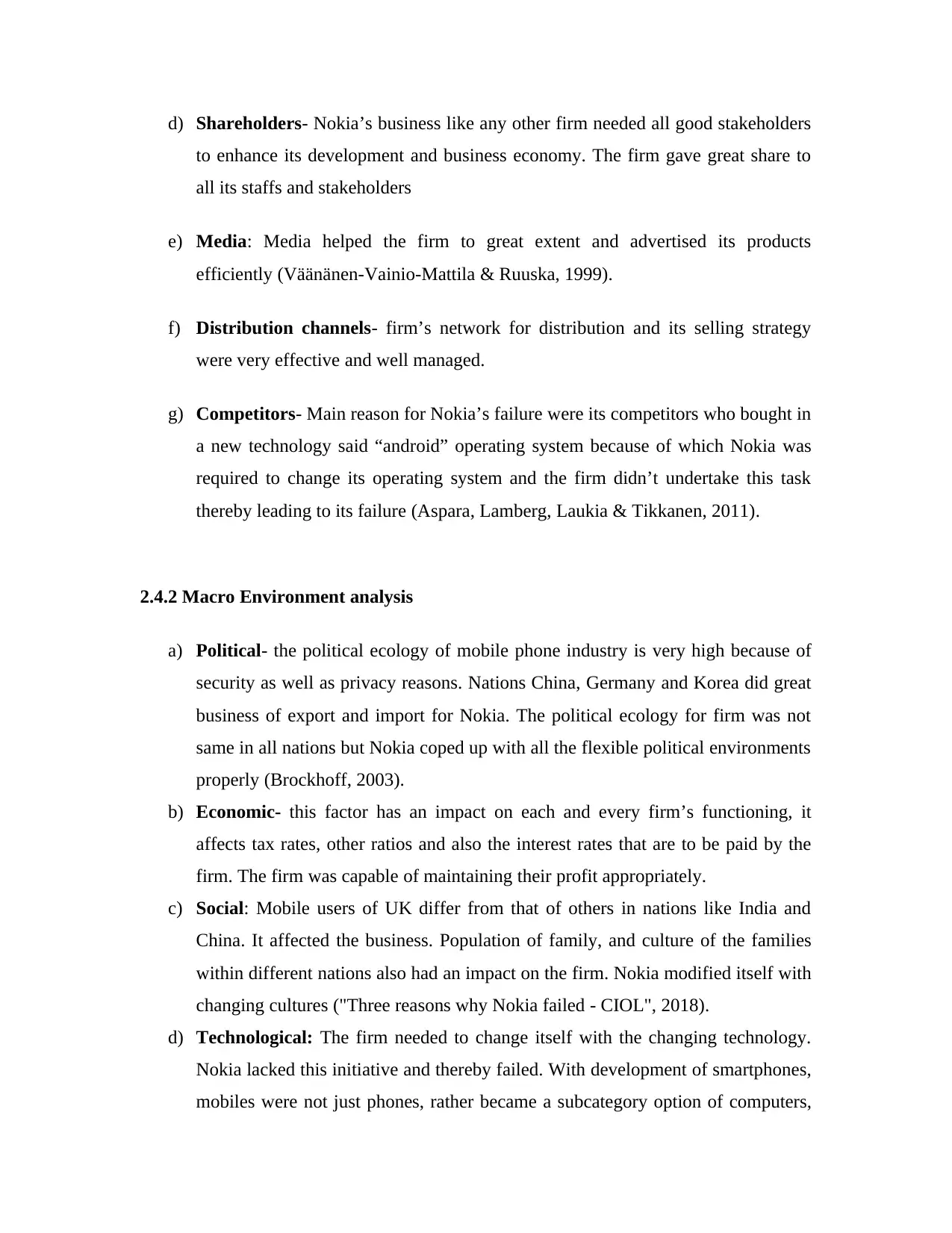
d) Shareholders- Nokia’s business like any other firm needed all good stakeholders
to enhance its development and business economy. The firm gave great share to
all its staffs and stakeholders
e) Media: Media helped the firm to great extent and advertised its products
efficiently (Väänänen-Vainio-Mattila & Ruuska, 1999).
f) Distribution channels- firm’s network for distribution and its selling strategy
were very effective and well managed.
g) Competitors- Main reason for Nokia’s failure were its competitors who bought in
a new technology said “android” operating system because of which Nokia was
required to change its operating system and the firm didn’t undertake this task
thereby leading to its failure (Aspara, Lamberg, Laukia & Tikkanen, 2011).
2.4.2 Macro Environment analysis
a) Political- the political ecology of mobile phone industry is very high because of
security as well as privacy reasons. Nations China, Germany and Korea did great
business of export and import for Nokia. The political ecology for firm was not
same in all nations but Nokia coped up with all the flexible political environments
properly (Brockhoff, 2003).
b) Economic- this factor has an impact on each and every firm’s functioning, it
affects tax rates, other ratios and also the interest rates that are to be paid by the
firm. The firm was capable of maintaining their profit appropriately.
c) Social: Mobile users of UK differ from that of others in nations like India and
China. It affected the business. Population of family, and culture of the families
within different nations also had an impact on the firm. Nokia modified itself with
changing cultures ("Three reasons why Nokia failed - CIOL", 2018).
d) Technological: The firm needed to change itself with the changing technology.
Nokia lacked this initiative and thereby failed. With development of smartphones,
mobiles were not just phones, rather became a subcategory option of computers,
to enhance its development and business economy. The firm gave great share to
all its staffs and stakeholders
e) Media: Media helped the firm to great extent and advertised its products
efficiently (Väänänen-Vainio-Mattila & Ruuska, 1999).
f) Distribution channels- firm’s network for distribution and its selling strategy
were very effective and well managed.
g) Competitors- Main reason for Nokia’s failure were its competitors who bought in
a new technology said “android” operating system because of which Nokia was
required to change its operating system and the firm didn’t undertake this task
thereby leading to its failure (Aspara, Lamberg, Laukia & Tikkanen, 2011).
2.4.2 Macro Environment analysis
a) Political- the political ecology of mobile phone industry is very high because of
security as well as privacy reasons. Nations China, Germany and Korea did great
business of export and import for Nokia. The political ecology for firm was not
same in all nations but Nokia coped up with all the flexible political environments
properly (Brockhoff, 2003).
b) Economic- this factor has an impact on each and every firm’s functioning, it
affects tax rates, other ratios and also the interest rates that are to be paid by the
firm. The firm was capable of maintaining their profit appropriately.
c) Social: Mobile users of UK differ from that of others in nations like India and
China. It affected the business. Population of family, and culture of the families
within different nations also had an impact on the firm. Nokia modified itself with
changing cultures ("Three reasons why Nokia failed - CIOL", 2018).
d) Technological: The firm needed to change itself with the changing technology.
Nokia lacked this initiative and thereby failed. With development of smartphones,
mobiles were not just phones, rather became a subcategory option of computers,
Paraphrase This Document
Need a fresh take? Get an instant paraphrase of this document with our AI Paraphraser
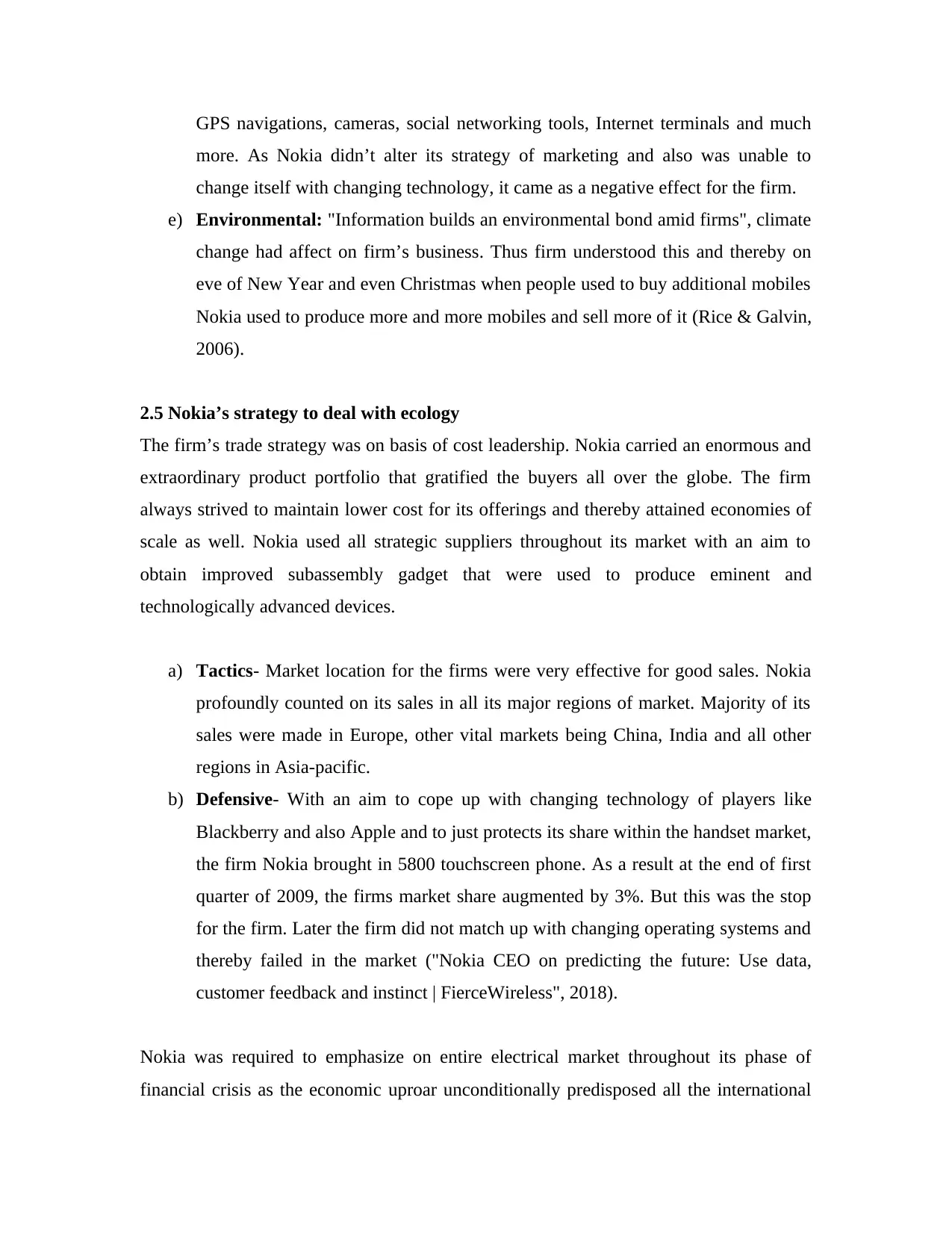
GPS navigations, cameras, social networking tools, Internet terminals and much
more. As Nokia didn’t alter its strategy of marketing and also was unable to
change itself with changing technology, it came as a negative effect for the firm.
e) Environmental: "Information builds an environmental bond amid firms", climate
change had affect on firm’s business. Thus firm understood this and thereby on
eve of New Year and even Christmas when people used to buy additional mobiles
Nokia used to produce more and more mobiles and sell more of it (Rice & Galvin,
2006).
2.5 Nokia’s strategy to deal with ecology
The firm’s trade strategy was on basis of cost leadership. Nokia carried an enormous and
extraordinary product portfolio that gratified the buyers all over the globe. The firm
always strived to maintain lower cost for its offerings and thereby attained economies of
scale as well. Nokia used all strategic suppliers throughout its market with an aim to
obtain improved subassembly gadget that were used to produce eminent and
technologically advanced devices.
a) Tactics- Market location for the firms were very effective for good sales. Nokia
profoundly counted on its sales in all its major regions of market. Majority of its
sales were made in Europe, other vital markets being China, India and all other
regions in Asia-pacific.
b) Defensive- With an aim to cope up with changing technology of players like
Blackberry and also Apple and to just protects its share within the handset market,
the firm Nokia brought in 5800 touchscreen phone. As a result at the end of first
quarter of 2009, the firms market share augmented by 3%. But this was the stop
for the firm. Later the firm did not match up with changing operating systems and
thereby failed in the market ("Nokia CEO on predicting the future: Use data,
customer feedback and instinct | FierceWireless", 2018).
Nokia was required to emphasize on entire electrical market throughout its phase of
financial crisis as the economic uproar unconditionally predisposed all the international
more. As Nokia didn’t alter its strategy of marketing and also was unable to
change itself with changing technology, it came as a negative effect for the firm.
e) Environmental: "Information builds an environmental bond amid firms", climate
change had affect on firm’s business. Thus firm understood this and thereby on
eve of New Year and even Christmas when people used to buy additional mobiles
Nokia used to produce more and more mobiles and sell more of it (Rice & Galvin,
2006).
2.5 Nokia’s strategy to deal with ecology
The firm’s trade strategy was on basis of cost leadership. Nokia carried an enormous and
extraordinary product portfolio that gratified the buyers all over the globe. The firm
always strived to maintain lower cost for its offerings and thereby attained economies of
scale as well. Nokia used all strategic suppliers throughout its market with an aim to
obtain improved subassembly gadget that were used to produce eminent and
technologically advanced devices.
a) Tactics- Market location for the firms were very effective for good sales. Nokia
profoundly counted on its sales in all its major regions of market. Majority of its
sales were made in Europe, other vital markets being China, India and all other
regions in Asia-pacific.
b) Defensive- With an aim to cope up with changing technology of players like
Blackberry and also Apple and to just protects its share within the handset market,
the firm Nokia brought in 5800 touchscreen phone. As a result at the end of first
quarter of 2009, the firms market share augmented by 3%. But this was the stop
for the firm. Later the firm did not match up with changing operating systems and
thereby failed in the market ("Nokia CEO on predicting the future: Use data,
customer feedback and instinct | FierceWireless", 2018).
Nokia was required to emphasize on entire electrical market throughout its phase of
financial crisis as the economic uproar unconditionally predisposed all the international
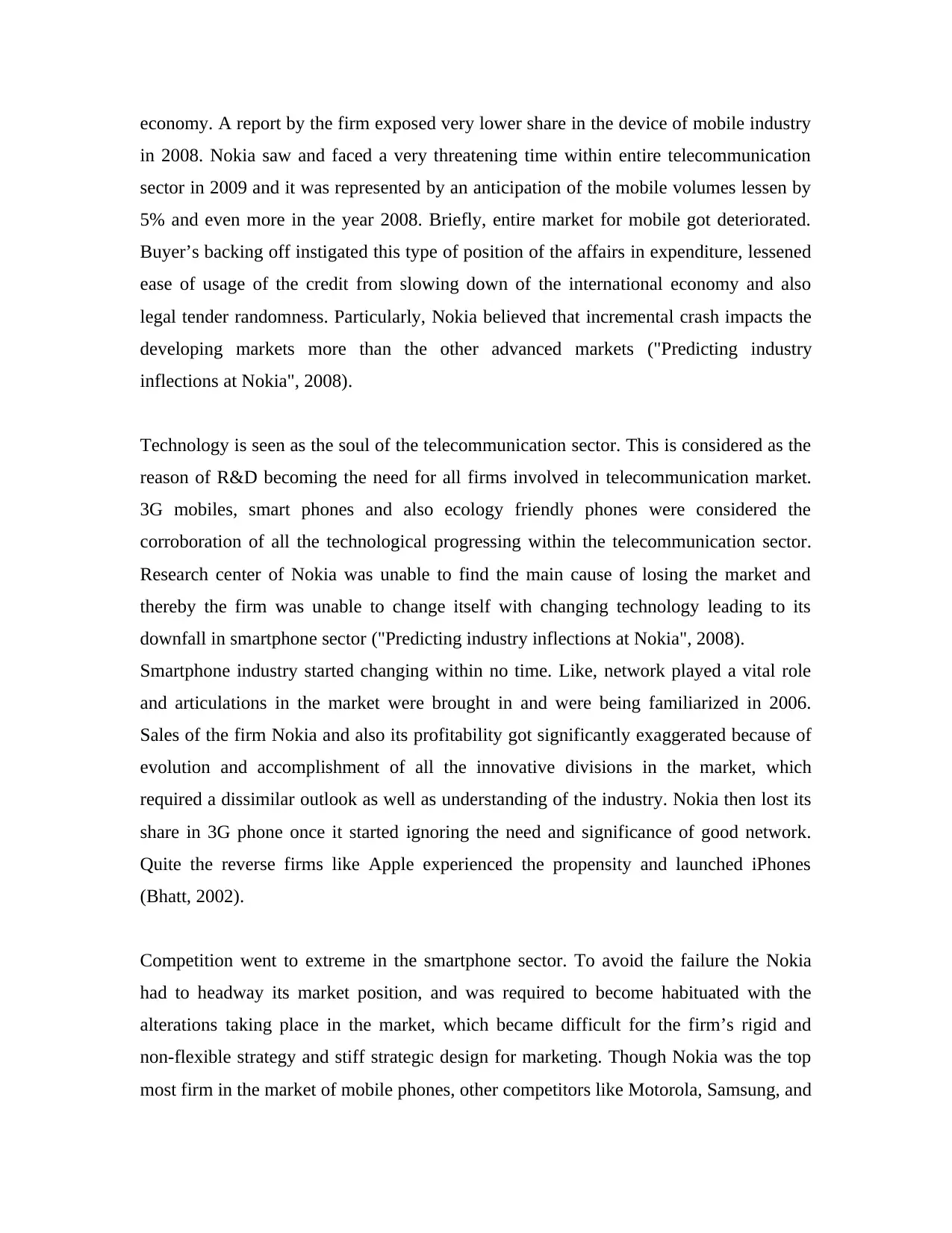
economy. A report by the firm exposed very lower share in the device of mobile industry
in 2008. Nokia saw and faced a very threatening time within entire telecommunication
sector in 2009 and it was represented by an anticipation of the mobile volumes lessen by
5% and even more in the year 2008. Briefly, entire market for mobile got deteriorated.
Buyer’s backing off instigated this type of position of the affairs in expenditure, lessened
ease of usage of the credit from slowing down of the international economy and also
legal tender randomness. Particularly, Nokia believed that incremental crash impacts the
developing markets more than the other advanced markets ("Predicting industry
inflections at Nokia", 2008).
Technology is seen as the soul of the telecommunication sector. This is considered as the
reason of R&D becoming the need for all firms involved in telecommunication market.
3G mobiles, smart phones and also ecology friendly phones were considered the
corroboration of all the technological progressing within the telecommunication sector.
Research center of Nokia was unable to find the main cause of losing the market and
thereby the firm was unable to change itself with changing technology leading to its
downfall in smartphone sector ("Predicting industry inflections at Nokia", 2008).
Smartphone industry started changing within no time. Like, network played a vital role
and articulations in the market were brought in and were being familiarized in 2006.
Sales of the firm Nokia and also its profitability got significantly exaggerated because of
evolution and accomplishment of all the innovative divisions in the market, which
required a dissimilar outlook as well as understanding of the industry. Nokia then lost its
share in 3G phone once it started ignoring the need and significance of good network.
Quite the reverse firms like Apple experienced the propensity and launched iPhones
(Bhatt, 2002).
Competition went to extreme in the smartphone sector. To avoid the failure the Nokia
had to headway its market position, and was required to become habituated with the
alterations taking place in the market, which became difficult for the firm’s rigid and
non-flexible strategy and stiff strategic design for marketing. Though Nokia was the top
most firm in the market of mobile phones, other competitors like Motorola, Samsung, and
in 2008. Nokia saw and faced a very threatening time within entire telecommunication
sector in 2009 and it was represented by an anticipation of the mobile volumes lessen by
5% and even more in the year 2008. Briefly, entire market for mobile got deteriorated.
Buyer’s backing off instigated this type of position of the affairs in expenditure, lessened
ease of usage of the credit from slowing down of the international economy and also
legal tender randomness. Particularly, Nokia believed that incremental crash impacts the
developing markets more than the other advanced markets ("Predicting industry
inflections at Nokia", 2008).
Technology is seen as the soul of the telecommunication sector. This is considered as the
reason of R&D becoming the need for all firms involved in telecommunication market.
3G mobiles, smart phones and also ecology friendly phones were considered the
corroboration of all the technological progressing within the telecommunication sector.
Research center of Nokia was unable to find the main cause of losing the market and
thereby the firm was unable to change itself with changing technology leading to its
downfall in smartphone sector ("Predicting industry inflections at Nokia", 2008).
Smartphone industry started changing within no time. Like, network played a vital role
and articulations in the market were brought in and were being familiarized in 2006.
Sales of the firm Nokia and also its profitability got significantly exaggerated because of
evolution and accomplishment of all the innovative divisions in the market, which
required a dissimilar outlook as well as understanding of the industry. Nokia then lost its
share in 3G phone once it started ignoring the need and significance of good network.
Quite the reverse firms like Apple experienced the propensity and launched iPhones
(Bhatt, 2002).
Competition went to extreme in the smartphone sector. To avoid the failure the Nokia
had to headway its market position, and was required to become habituated with the
alterations taking place in the market, which became difficult for the firm’s rigid and
non-flexible strategy and stiff strategic design for marketing. Though Nokia was the top
most firm in the market of mobile phones, other competitors like Motorola, Samsung, and
⊘ This is a preview!⊘
Do you want full access?
Subscribe today to unlock all pages.

Trusted by 1+ million students worldwide
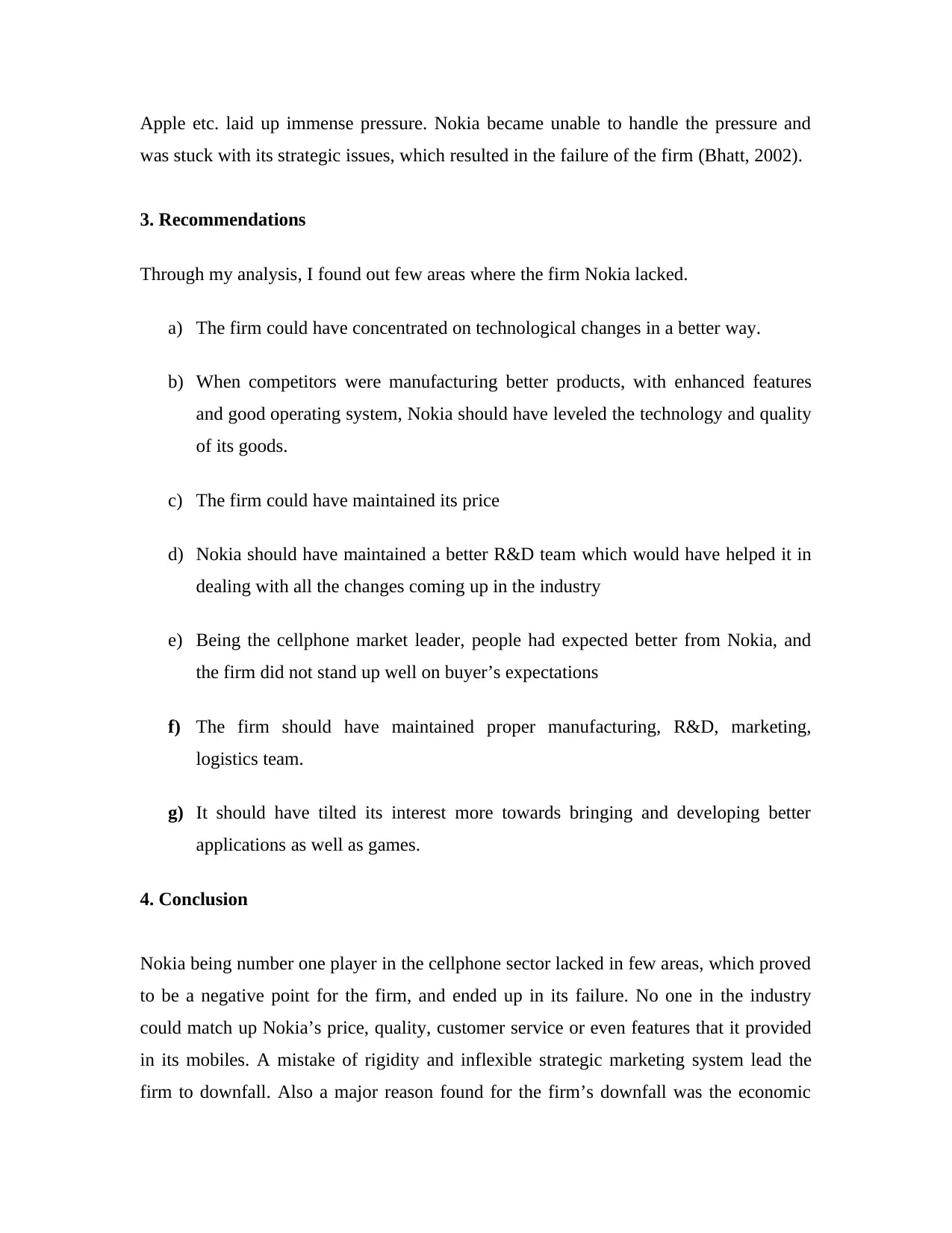
Apple etc. laid up immense pressure. Nokia became unable to handle the pressure and
was stuck with its strategic issues, which resulted in the failure of the firm (Bhatt, 2002).
3. Recommendations
Through my analysis, I found out few areas where the firm Nokia lacked.
a) The firm could have concentrated on technological changes in a better way.
b) When competitors were manufacturing better products, with enhanced features
and good operating system, Nokia should have leveled the technology and quality
of its goods.
c) The firm could have maintained its price
d) Nokia should have maintained a better R&D team which would have helped it in
dealing with all the changes coming up in the industry
e) Being the cellphone market leader, people had expected better from Nokia, and
the firm did not stand up well on buyer’s expectations
f) The firm should have maintained proper manufacturing, R&D, marketing,
logistics team.
g) It should have tilted its interest more towards bringing and developing better
applications as well as games.
4. Conclusion
Nokia being number one player in the cellphone sector lacked in few areas, which proved
to be a negative point for the firm, and ended up in its failure. No one in the industry
could match up Nokia’s price, quality, customer service or even features that it provided
in its mobiles. A mistake of rigidity and inflexible strategic marketing system lead the
firm to downfall. Also a major reason found for the firm’s downfall was the economic
was stuck with its strategic issues, which resulted in the failure of the firm (Bhatt, 2002).
3. Recommendations
Through my analysis, I found out few areas where the firm Nokia lacked.
a) The firm could have concentrated on technological changes in a better way.
b) When competitors were manufacturing better products, with enhanced features
and good operating system, Nokia should have leveled the technology and quality
of its goods.
c) The firm could have maintained its price
d) Nokia should have maintained a better R&D team which would have helped it in
dealing with all the changes coming up in the industry
e) Being the cellphone market leader, people had expected better from Nokia, and
the firm did not stand up well on buyer’s expectations
f) The firm should have maintained proper manufacturing, R&D, marketing,
logistics team.
g) It should have tilted its interest more towards bringing and developing better
applications as well as games.
4. Conclusion
Nokia being number one player in the cellphone sector lacked in few areas, which proved
to be a negative point for the firm, and ended up in its failure. No one in the industry
could match up Nokia’s price, quality, customer service or even features that it provided
in its mobiles. A mistake of rigidity and inflexible strategic marketing system lead the
firm to downfall. Also a major reason found for the firm’s downfall was the economic
Paraphrase This Document
Need a fresh take? Get an instant paraphrase of this document with our AI Paraphraser
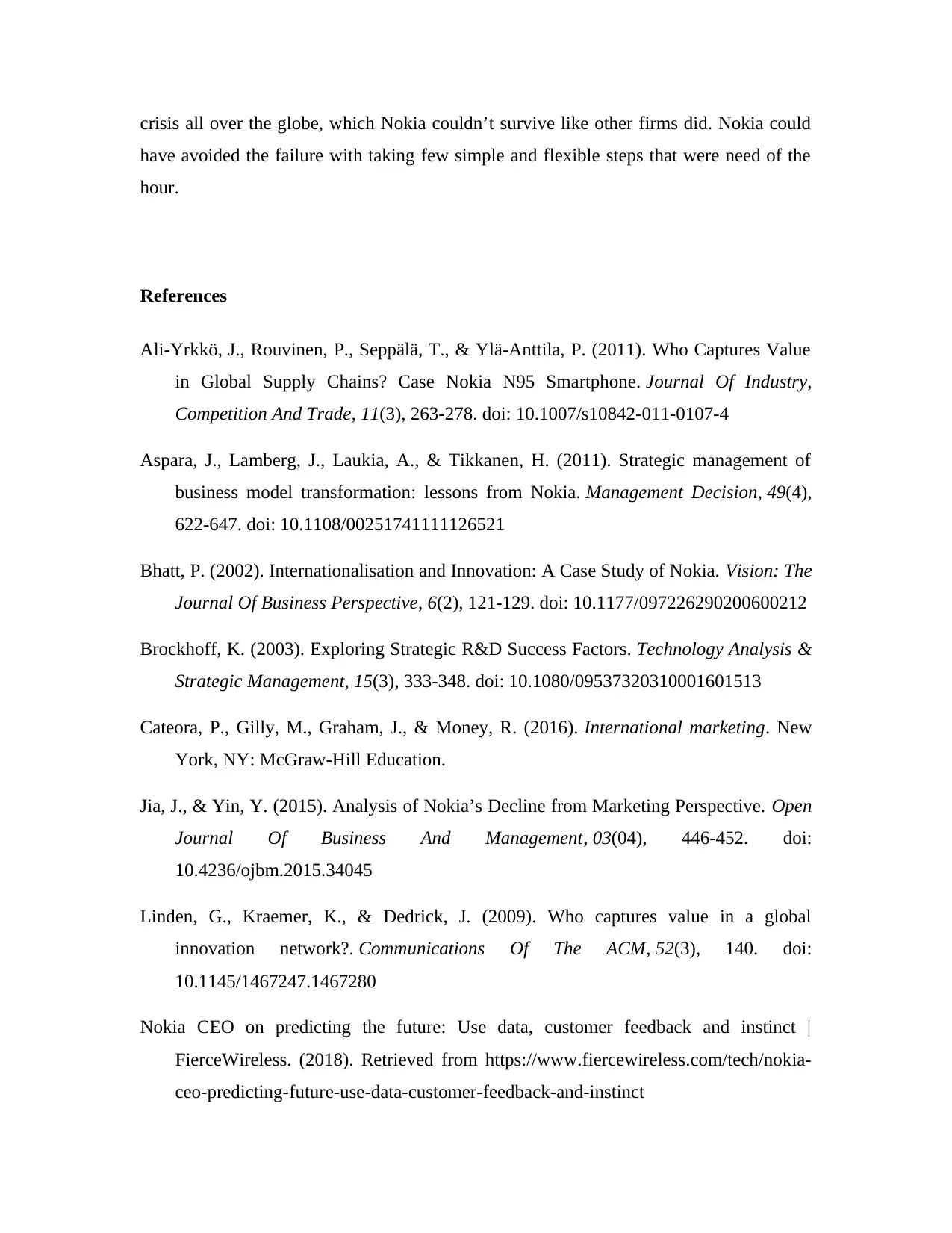
crisis all over the globe, which Nokia couldn’t survive like other firms did. Nokia could
have avoided the failure with taking few simple and flexible steps that were need of the
hour.
References
Ali-Yrkkö, J., Rouvinen, P., Seppälä, T., & Ylä-Anttila, P. (2011). Who Captures Value
in Global Supply Chains? Case Nokia N95 Smartphone. Journal Of Industry,
Competition And Trade, 11(3), 263-278. doi: 10.1007/s10842-011-0107-4
Aspara, J., Lamberg, J., Laukia, A., & Tikkanen, H. (2011). Strategic management of
business model transformation: lessons from Nokia. Management Decision, 49(4),
622-647. doi: 10.1108/00251741111126521
Bhatt, P. (2002). Internationalisation and Innovation: A Case Study of Nokia. Vision: The
Journal Of Business Perspective, 6(2), 121-129. doi: 10.1177/097226290200600212
Brockhoff, K. (2003). Exploring Strategic R&D Success Factors. Technology Analysis &
Strategic Management, 15(3), 333-348. doi: 10.1080/09537320310001601513
Cateora, P., Gilly, M., Graham, J., & Money, R. (2016). International marketing. New
York, NY: McGraw-Hill Education.
Jia, J., & Yin, Y. (2015). Analysis of Nokia’s Decline from Marketing Perspective. Open
Journal Of Business And Management, 03(04), 446-452. doi:
10.4236/ojbm.2015.34045
Linden, G., Kraemer, K., & Dedrick, J. (2009). Who captures value in a global
innovation network?. Communications Of The ACM, 52(3), 140. doi:
10.1145/1467247.1467280
Nokia CEO on predicting the future: Use data, customer feedback and instinct |
FierceWireless. (2018). Retrieved from https://www.fiercewireless.com/tech/nokia-
ceo-predicting-future-use-data-customer-feedback-and-instinct
have avoided the failure with taking few simple and flexible steps that were need of the
hour.
References
Ali-Yrkkö, J., Rouvinen, P., Seppälä, T., & Ylä-Anttila, P. (2011). Who Captures Value
in Global Supply Chains? Case Nokia N95 Smartphone. Journal Of Industry,
Competition And Trade, 11(3), 263-278. doi: 10.1007/s10842-011-0107-4
Aspara, J., Lamberg, J., Laukia, A., & Tikkanen, H. (2011). Strategic management of
business model transformation: lessons from Nokia. Management Decision, 49(4),
622-647. doi: 10.1108/00251741111126521
Bhatt, P. (2002). Internationalisation and Innovation: A Case Study of Nokia. Vision: The
Journal Of Business Perspective, 6(2), 121-129. doi: 10.1177/097226290200600212
Brockhoff, K. (2003). Exploring Strategic R&D Success Factors. Technology Analysis &
Strategic Management, 15(3), 333-348. doi: 10.1080/09537320310001601513
Cateora, P., Gilly, M., Graham, J., & Money, R. (2016). International marketing. New
York, NY: McGraw-Hill Education.
Jia, J., & Yin, Y. (2015). Analysis of Nokia’s Decline from Marketing Perspective. Open
Journal Of Business And Management, 03(04), 446-452. doi:
10.4236/ojbm.2015.34045
Linden, G., Kraemer, K., & Dedrick, J. (2009). Who captures value in a global
innovation network?. Communications Of The ACM, 52(3), 140. doi:
10.1145/1467247.1467280
Nokia CEO on predicting the future: Use data, customer feedback and instinct |
FierceWireless. (2018). Retrieved from https://www.fiercewireless.com/tech/nokia-
ceo-predicting-future-use-data-customer-feedback-and-instinct
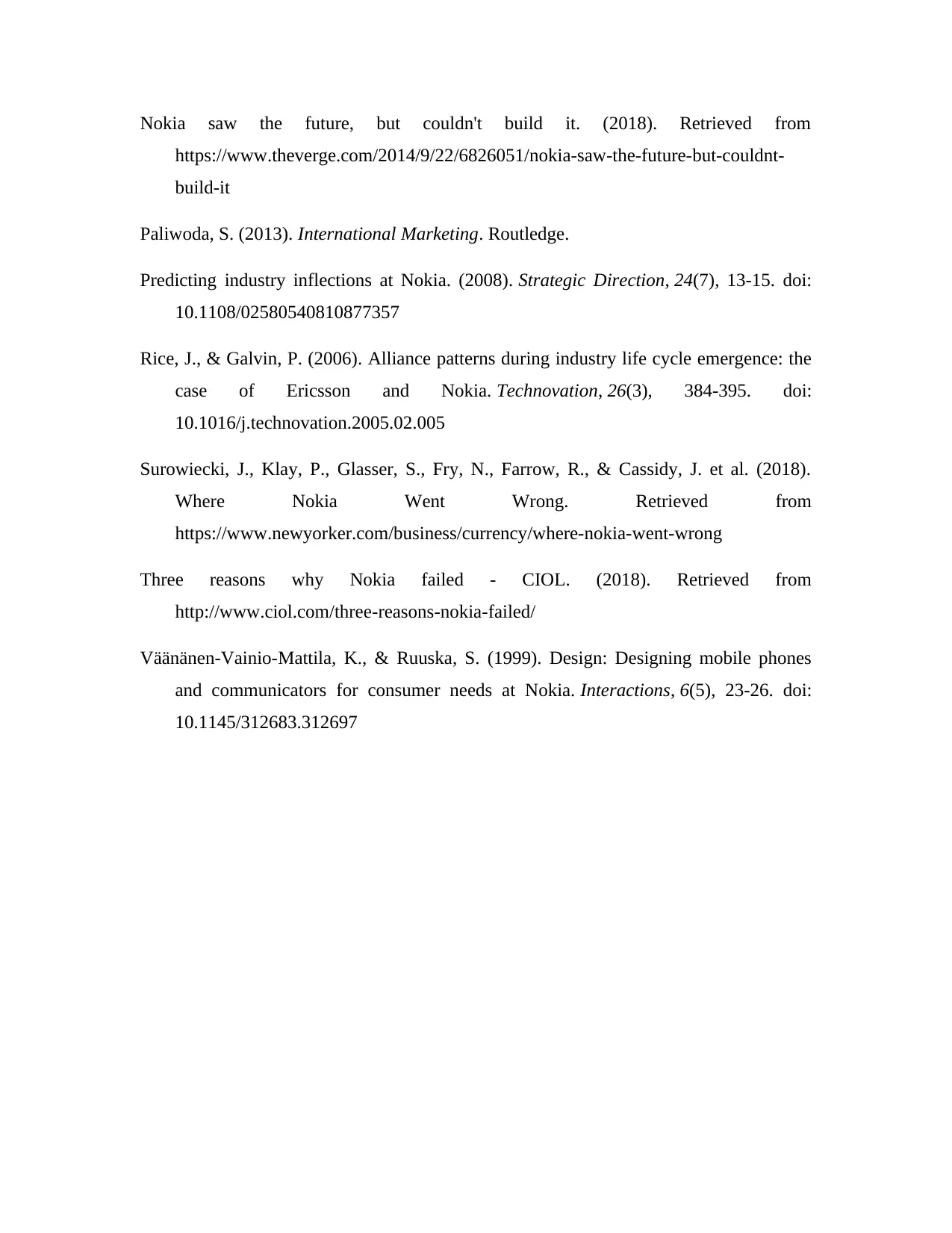
Nokia saw the future, but couldn't build it. (2018). Retrieved from
https://www.theverge.com/2014/9/22/6826051/nokia-saw-the-future-but-couldnt-
build-it
Paliwoda, S. (2013). International Marketing. Routledge.
Predicting industry inflections at Nokia. (2008). Strategic Direction, 24(7), 13-15. doi:
10.1108/02580540810877357
Rice, J., & Galvin, P. (2006). Alliance patterns during industry life cycle emergence: the
case of Ericsson and Nokia. Technovation, 26(3), 384-395. doi:
10.1016/j.technovation.2005.02.005
Surowiecki, J., Klay, P., Glasser, S., Fry, N., Farrow, R., & Cassidy, J. et al. (2018).
Where Nokia Went Wrong. Retrieved from
https://www.newyorker.com/business/currency/where-nokia-went-wrong
Three reasons why Nokia failed - CIOL. (2018). Retrieved from
http://www.ciol.com/three-reasons-nokia-failed/
Väänänen-Vainio-Mattila, K., & Ruuska, S. (1999). Design: Designing mobile phones
and communicators for consumer needs at Nokia. Interactions, 6(5), 23-26. doi:
10.1145/312683.312697
https://www.theverge.com/2014/9/22/6826051/nokia-saw-the-future-but-couldnt-
build-it
Paliwoda, S. (2013). International Marketing. Routledge.
Predicting industry inflections at Nokia. (2008). Strategic Direction, 24(7), 13-15. doi:
10.1108/02580540810877357
Rice, J., & Galvin, P. (2006). Alliance patterns during industry life cycle emergence: the
case of Ericsson and Nokia. Technovation, 26(3), 384-395. doi:
10.1016/j.technovation.2005.02.005
Surowiecki, J., Klay, P., Glasser, S., Fry, N., Farrow, R., & Cassidy, J. et al. (2018).
Where Nokia Went Wrong. Retrieved from
https://www.newyorker.com/business/currency/where-nokia-went-wrong
Three reasons why Nokia failed - CIOL. (2018). Retrieved from
http://www.ciol.com/three-reasons-nokia-failed/
Väänänen-Vainio-Mattila, K., & Ruuska, S. (1999). Design: Designing mobile phones
and communicators for consumer needs at Nokia. Interactions, 6(5), 23-26. doi:
10.1145/312683.312697
⊘ This is a preview!⊘
Do you want full access?
Subscribe today to unlock all pages.

Trusted by 1+ million students worldwide
1 out of 9
Related Documents
Your All-in-One AI-Powered Toolkit for Academic Success.
+13062052269
info@desklib.com
Available 24*7 on WhatsApp / Email
![[object Object]](/_next/static/media/star-bottom.7253800d.svg)
Unlock your academic potential
Copyright © 2020–2025 A2Z Services. All Rights Reserved. Developed and managed by ZUCOL.





